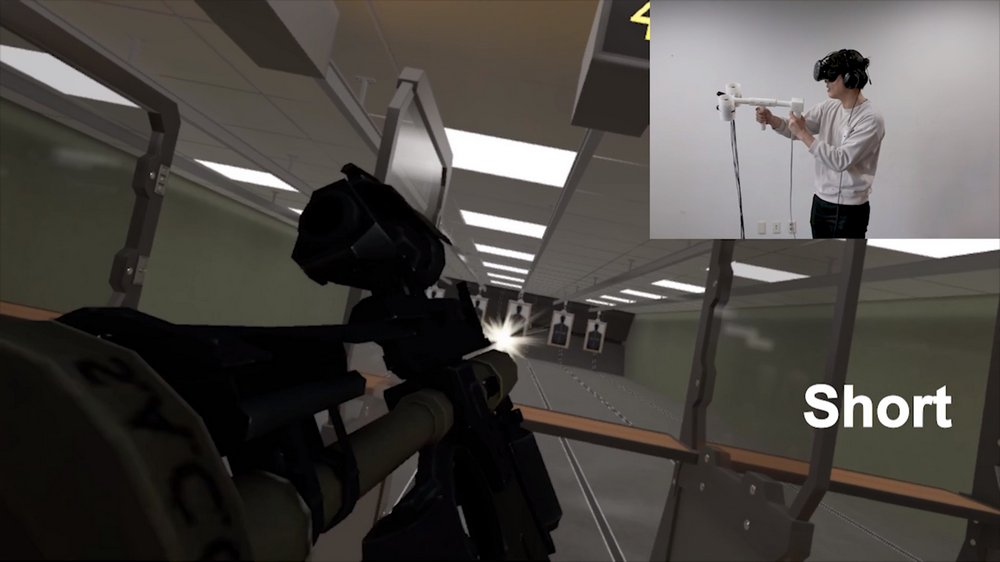Korean Institute Develops ‘Aero-Plane’ Force-Feedback Haptic Controller Prototype
Players have largely been become accustomed to the lack of gravity or weight when holding objects in the virtual environment but it ends up ruining the fluidity of the immersion.
To solve this problem and add some realism into the virtual reality experiences, various startups and research institutes are coming up with a number of haptic solutions. So far, the search for the ideal and practical haptic virtual reality controller has had lots of promise and expectations but without any tangible results in terms of a practical and miniaturized device that can be seamlessly integrated into the virtual reality controllers to get a real feel of touch and weight in VR.

Several attempts have been tried so far ranging from the haptic gloves (such as the HaptX gloves) to body suits (such as the holosuits) and omnidirectional treadmill. The race is on to make the virtual world tangible and even more immersive. However, most of the advanced haptic controllers and devices are still largely experimental. Many of them are just research concepts, prototypes or the more expensive and bulkier original versions that are still not practical in the usage environment.
The latest attempt is by the Korea Advanced Institute of Science and Technology (KAIST) and involves the use of various forms of force-feedback for virtual reality applications. The institute’s prototype is known as Aero-Plane and it has been designed to simulate weight and mass in virtual reality.
Aero-Plane: Simulating Weight through the use of mini-turbines
The Aero-Plane is a force-feedback controller that is designed to make weight changes in virtual reality noticeable. The Aero-Plane concept is based on two turbine-like fans. It attaches the fans to a controller device to create a continual airflow stream. This process helps create an illusion of weight and of shifting mass in the virtual object which will make the controller feel lighter or heavier depending on the speed of the airflow which corresponds to the weight of the virtual object.
The fans have been directly attached to the controller and will provide airflow based on the object that the virtual reality is interacting with. If you lift an assault rifle in VR, for example, you will be able to feel not only the weight but also the recoil.
The two turbines will generate an airflow capable of dynamically converting a weight of 14 Newton in 0.3 seconds. This allows you to simulate a weight of up to 1.5kg in virtual reality.
The simulated weight may not be the same as that of the real object but every noticeable feeling of weight in VR goes a long way in making VR immersion more real.
Just Another Promising prototype?
In a yet another presentation, the team working at the Korean Institute rolled a ball around the virtual platform and the user on the controller was able to balance the ball using a VR controller. The weight changes were directly implemented by the fans.
Currently, most of the traditional haptic devices such as the motion controllers used for HTC Vive and Oculus Rift work based on a basic rumble feature which makes players feel connected to the VR experience.
The Aero-Plane force-feedback controllers extends this so that instead of just feeling the sensations, you are also able to feel some weight. When user is carrying an unstable load, the weight may have to shift a bit and this has to be compensated for by the fan system.
The KAIST demonstration video shows the research team using a ball which rolls around the 2D plane and the user is able to accurately roll the ball around. The force feedback can be used in multiple settings, particularly in the gun range where you have weapons with multiple handling characteristics like the weight, size and recoil travel. Using a device such as the Aero-Plane can help simulate some of these characteristics.
For now, the Aero-Plane force-feedback controller is nothing more than just another promising haptic feedback prototype. The loudness of the fans is still not apparent. Besides, the Aero-Plane controller must be powered by an external power source that is connected via several cables and it is quite bulky.
It will be quite some time before such a controller is refined for practical use in the market. But it represents another promising step in the pursuit of realistic haptic feedback in virtual reality.
https://virtualrealitytimes.com/2019/08/11/korean-institute-develops-aero-plane-force-feedback-haptic-controller-prototype/https://virtualrealitytimes.com/wp-content/uploads/2019/08/Aero-Plane-Haptic-Controller-600x337.jpghttps://virtualrealitytimes.com/wp-content/uploads/2019/08/Aero-Plane-Haptic-Controller-150x90.jpgHapticsHardwareTechnologyPlayers have largely been become accustomed to the lack of gravity or weight when holding objects in the virtual environment but it ends up ruining the fluidity of the immersion. To solve this problem and add some realism into the virtual reality experiences, various startups and research institutes are coming...Sam OchanjiSam Ochanji[email protected]EditorVirtual Reality Times - Metaverse & VR
